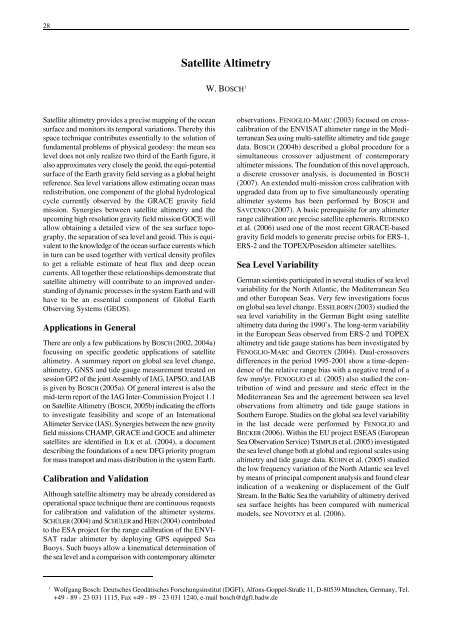NATIONAL REPORT OF THE FEDERAL REPUBLIC OF ... - IAG Office
NATIONAL REPORT OF THE FEDERAL REPUBLIC OF ... - IAG Office
NATIONAL REPORT OF THE FEDERAL REPUBLIC OF ... - IAG Office
Create successful ePaper yourself
Turn your PDF publications into a flip-book with our unique Google optimized e-Paper software.
28<br />
Satellite altimetry provides a precise mapping of the ocean<br />
surface and monitors its temporal variations. Thereby this<br />
space technique contributes essentially to the solution of<br />
fundamental problems of physical geodesy: the mean sea<br />
level does not only realize two third of the Earth figure, it<br />
also approximates very closely the geoid, the equi-potential<br />
surface of the Earth gravity field serving as a global height<br />
reference. Sea level variations allow estimating ocean mass<br />
redistribution, one component of the global hydrological<br />
cycle currently observed by the GRACE gravity field<br />
mission. Synergies between satellite altimetry and the<br />
upcoming high resolution gravity field mission GOCE will<br />
allow obtaining a detailed view of the sea surface topography,<br />
the separation of sea level and geoid. This is equivalent<br />
to the knowledge of the ocean surface currents which<br />
in turn can be used together with vertical density profiles<br />
to get a reliable estimate of heat flux and deep ocean<br />
currents. All together these relationships demonstrate that<br />
satellite altimetry will contribute to an improved understanding<br />
of dynamic processes in the system Earth and will<br />
have to be an essential component of Global Earth<br />
Observing Systems (GEOS).<br />
Applications in General<br />
There are only a few publications by BOSCH (2002, 2004a)<br />
focussing on specific geodetic applications of satellite<br />
altimetry. A summary report on global sea level change,<br />
altimetry, GNSS and tide gauge measurement treated on<br />
session GP2 of the joint Assembly of <strong>IAG</strong>, IAPSO, and IAB<br />
is given by BOSCH (2005a). Of general interest is also the<br />
mid-term report of the <strong>IAG</strong> Inter-Commission Project 1.1<br />
on Satellite Altimetry (BOSCH, 2005b) indicating the efforts<br />
to investigate feasibility and scope of an International<br />
Altimeter Service (IAS). Synergies between the new gravity<br />
field missions CHAMP, GRACE and GOCE and altimeter<br />
satellites are identified in ILK et al. (2004), a document<br />
describing the foundations of a new DFG priority program<br />
for mass transport and mass distribution in the system Earth.<br />
Calibration and Validation<br />
Although satellite altimetry may be already considered as<br />
operational space technique there are continuous requests<br />
for calibration and validation of the altimeter systems.<br />
SCHÜLER (2004) and SCHÜLER and HEIN (2004) contributed<br />
to the ESA project for the range calibration of the ENVI-<br />
SAT radar altimeter by deploying GPS equipped Sea<br />
Buoys. Such buoys allow a kinematical determination of<br />
the sea level and a comparison with contemporary altimeter<br />
Satellite Altimetry<br />
W. BOSCH 1<br />
observations. FENOGLIO-MARC (2003) focused on crosscalibration<br />
of the ENVISAT altimeter range in the Mediterranean<br />
Sea using multi-satellite altimetry and tide gauge<br />
data. BOSCH (2004b) described a global procedure for a<br />
simultaneous crossover adjustment of contemporary<br />
altimeter missions. The foundation of this novel approach,<br />
a discrete crossover analysis, is documented in BOSCH<br />
(2007). An extended multi-mission cross calibration with<br />
upgraded data from up to five simultaneously operating<br />
altimeter systems has been performed by BOSCH and<br />
SAVCENKO (2007). A basic prerequisite for any altimeter<br />
range calibration are precise satellite ephemeris. RUDENKO<br />
et al. (2006) used one of the most recent GRACE-based<br />
gravity field models to generate precise orbits for ERS-1,<br />
ERS-2 and the TOPEX/Poseidon altimeter satellites.<br />
Sea Level Variability<br />
German scientists participated in several studies of sea level<br />
variability for the North Atlantic, the Mediterranean Sea<br />
and other European Seas. Very few investigations focus<br />
on global sea level change. ESSELBORN (2003) studied the<br />
sea level variability in the German Bight using satellite<br />
altimetry data during the 1990’s. The long-term variability<br />
in the European Seas observed from ERS-2 and TOPEX<br />
altimetry and tide gauge stations has been investigated by<br />
FENOGLIO-MARC and GROTEN (2004). Dual-crossovers<br />
differences in the period 1995-2001 show a time-dependence<br />
of the relative range bias with a negative trend of a<br />
few mm/yr. FENOGLIO et al. (2005) also studied the contribution<br />
of wind and pressure and steric effect in the<br />
Mediterranean Sea and the agreement between sea level<br />
observations from altimetry and tide gauge stations in<br />
Southern Europe. Studies on the global sea level variability<br />
in the last decade were performed by FENOGLIO and<br />
BECKER (2006). Within the EU project ESEAS (European<br />
Sea Observation Service) TSIMPLIS et al. (2005) investigated<br />
the sea level change both at global and regional scales using<br />
altimetry and tide gauge data. KUHN et al. (2005) studied<br />
the low frequency variation of the North Atlantic sea level<br />
by means of principal component analysis and found clear<br />
indication of a weakening or displacement of the Gulf<br />
Stream. In the Baltic Sea the variability of altimetry derived<br />
sea surface heights has been compared with numerical<br />
models, see NOVOTNY et al. (2006).<br />
1 Wolfgang Bosch: Deutsches Geodätisches Forschungsinstitut (DGFI), Alfons-Goppel-Straße 11, D-80539 München, Germany, Tel.<br />
+49 - 89 - 23 031 1115, Fax +49 - 89 - 23 031 1240, e-mail bosch@dgfi.badw.de











